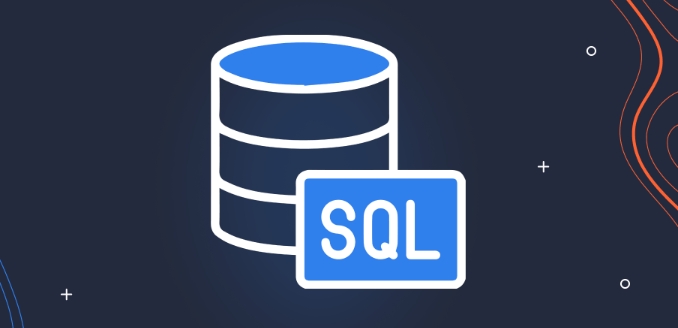How to use AND, OR, and NOT operators in SQL?
The use of AND, OR and NOT logical operators in SQL queries can filter data more accurately, especially for processing multiple conditions. 1. AND is used to satisfy multiple conditions at the same time. All conditions must be recorded before they will be returned. It is recommended to add brackets to improve readability when used continuously; 2. OR is used to match any condition. As long as one condition is met, the record can be returned. Note that AND has a higher priority than OR, and if necessary, brackets must be used to clarify the logic; 3. NOT is used to invert the conditional result, which can act on a single or a set of conditions. The rational use of logic can simplify complex queries. Pay special attention to the order and brackets when using it to ensure that the query logic is correct.

In SQL queries, AND, OR, and NOT are the most commonly used logical operators. They help you filter data more accurately, especially when dealing with multiple conditions. Below are some practical uses and precautions.

1. Use the AND operator to combine multiple conditions
When you need to meet multiple query conditions at the same time, you can use AND . It ensures that all conditions are true and the result will be returned.
For example, if you want to find that you are older than 30 years old and that the department is a sales employee:

SELECT * FROM employees WHERE age > 30 AND department = 'Sales';
- Separate conditions by
AND - All conditions must be true before records will appear in the results
- Multiple
ANDcan be used continuously, but it is recommended to use brackets to improve readability (especially when OR is involved)
2. Use the OR operator to match any condition
If you want to find data that meets any criteria, you can use OR . As long as one of the conditions is true, the bank will be selected.
For example, you want to find out that the department is a sales or salary of more than 8,000:

SELECT * FROM employees WHERE department = 'Sales' OR salary > 8000;
- Any condition is satisfied and the record is returned
- Pay attention to priority issues:
ANDis higher priority thanOR, and add brackets when necessary to avoid ambiguity
For example:
WHERE department = 'Sales' OR department = 'HR' AND salary > 8000
This is actually equivalent to:
WHERE department = 'Sales' OR (department = 'HR' AND salary > 8000)
If you want "the department is Sales or HR and the salary is above 8000", you need to write it as:
WHERE (department = 'Sales' OR department = 'HR') AND salary > 8000;
3. Use NOT operator to invert the condition
NOT can be used to invert the result of a certain condition. For example, if you want to find out that an employee is not a manager:
SELECT * FROM employees WHERE NOT job_title = 'Manager';
It can also be used with other operators, such as excluding certain departments:
SELECT * FROM employees WHERE NOT (department = 'IT' OR department = 'Admin');
-
NOTcan act on a single condition or on a set of conditions (wrapped in brackets) - In complex queries, the rational use of
NOTcan simplify logic
Basically that's it. AND, OR, NOT looks simple, but when actually writing queries, the use of order and brackets is easy to make mistakes. After writing, it is recommended to check whether the logic meets expectations.
The above is the detailed content of How to use AND, OR, and NOT operators in SQL?. For more information, please follow other related articles on the PHP Chinese website!

Hot AI Tools

Undress AI Tool
Undress images for free

Undresser.AI Undress
AI-powered app for creating realistic nude photos

AI Clothes Remover
Online AI tool for removing clothes from photos.

Clothoff.io
AI clothes remover

Video Face Swap
Swap faces in any video effortlessly with our completely free AI face swap tool!

Hot Article

Hot Tools

Notepad++7.3.1
Easy-to-use and free code editor

SublimeText3 Chinese version
Chinese version, very easy to use

Zend Studio 13.0.1
Powerful PHP integrated development environment

Dreamweaver CS6
Visual web development tools

SublimeText3 Mac version
God-level code editing software (SublimeText3)
 SQL Serverless Computing Options
Jul 27, 2025 am 03:07 AM
SQL Serverless Computing Options
Jul 27, 2025 am 03:07 AM
SQLServer itself does not support serverless architecture, but the cloud platform provides a similar solution. 1. Azure's ServerlessSQL pool can directly query DataLake files and charge based on resource consumption; 2. AzureFunctions combined with CosmosDB or BlobStorage can realize lightweight SQL processing; 3. AWSathena supports standard SQL queries for S3 data, and charge based on scanned data; 4. GoogleBigQuery approaches the Serverless concept through FederatedQuery; 5. If you must use SQLServer function, you can choose AzureSQLDatabase's serverless service-free
 How do you calculate the difference between two dates in SQL?
Aug 02, 2025 pm 01:29 PM
How do you calculate the difference between two dates in SQL?
Aug 02, 2025 pm 01:29 PM
To calculate the difference between two dates, you need to select the corresponding function according to the database type: 1. Use DATEDIFF() to calculate the day difference in MySQL, or specify the units such as HOUR and MINUTE in TIMESTAMPDIFF(); 2. Use DATEDIFF(date_part, start_date, end_date) in SQLServer and specify the units; 3. Use direct subtraction in PostgreSQL to obtain the day difference, or use EXTRACT(DAYFROMAGE(...)) to obtain more accurate intervals; 4. Use julianday() function to subtract the day difference in SQLite; always pay attention to the date order
 Mastering SQL for Business Intelligence Analytics
Jul 26, 2025 am 07:53 AM
Mastering SQL for Business Intelligence Analytics
Jul 26, 2025 am 07:53 AM
TomasterSQLforBIanalytics,startbyunderstandingBIdatastructureslikefactanddimensiontables,thenusestrategicaggregationswithGROUPBYandHAVING,leveragedatefunctionsfortime-basedanalysis,andwriteclean,maintainablequeries.First,graspdimensionalmodelingtojoi
 Implementing SQL Read Replicas for Scalability
Jul 25, 2025 am 02:40 AM
Implementing SQL Read Replicas for Scalability
Jul 25, 2025 am 02:40 AM
Read replicas are needed because most applications read more and write less, and the master library is easy to become a bottleneck; common settings include MySQL's master-slave replication, PostgreSQL's stream replication, SQLServer's AlwaysOn group, and RDS's ReadReplica instances; read requests can be judged through the application layer, and middleware or ORM frameworks are routed to the replica; problems that are easily overlooked include replication delays, improper connection pool configuration, missing health checks, and inadequate permission management.
 What are the BLOB and CLOB data types in SQL?
Aug 07, 2025 pm 04:22 PM
What are the BLOB and CLOB data types in SQL?
Aug 07, 2025 pm 04:22 PM
BLOBstoresbinarydatalikeimages,audio,orPDFsasrawbyteswithoutcharacterencoding,whileCLOBstoreslargetextsuchasarticlesorJSONusingcharacterencodinglikeUTF-8andsupportsstringoperations;2.Bothcanhandleuptogigabytesofdatadependingonthedatabase,butperforman
 SQL Cube and Rollup for Multi-Dimensional Aggregation
Jul 29, 2025 am 12:28 AM
SQL Cube and Rollup for Multi-Dimensional Aggregation
Jul 29, 2025 am 12:28 AM
CUBE is used to generate aggregation of all dimension combinations, suitable for cross-analysis; ROLLUP is gradually summarized at hierarchical levels, suitable for data with hierarchical relationships. CUBE generates a total of 8 combinations according to Region, Product, and Quarter, while ROLLUP generates a summary of year, month, day and other levels according to Year, Month, and Day. CUBE is suitable for viewing all cross-dimensional results, ROLLUP is suitable for displaying hierarchies. Note that CUBE may cause the result set to explode, and ROLLUP depends on the field order. The summary row can be identified through the GROUPING() function, and the total row is named with COALESCE to improve readability.
 What are aggregate functions in SQL?
Jul 26, 2025 am 05:43 AM
What are aggregate functions in SQL?
Jul 26, 2025 am 05:43 AM
SQL's aggregation function is used to calculate a single summary value from multiple rows of data. Common functions include SUM() summing, AVG() average value, COUNT() count, MAX() maximum value, and MIN() minimum value. These functions are often used in conjunction with GROUPBY to count the grouped data. For example, using SUM (units_sold) can get the total sales volume, adding GROUPBYproduct_id can count by product; COUNT() can count all records, and COUNT (sale_date) will ignore empty values. Note when using: NULL values are usually ignored, except COUNT(); mixed use of multiple functions may produce unexpected results; HAVI should be used to filter grouped data
 SQL for Blockchain Database Integration
Jul 25, 2025 am 02:44 AM
SQL for Blockchain Database Integration
Jul 25, 2025 am 02:44 AM
To use SQL to represent the blockchain structure and realize its characteristics, you can efficiently retrieve data by designing a chain table structure, using triggers to prevent tampering, periodically verifying the integrity of the hash chain, and using recursive queries and other methods. The specific steps include: 1. Create a table containing previous_hash, hash and data fields to simulate block link structure; 2. Use triggers to prevent update operations and ensure that data cannot be tampered with; 3. Regularly check whether the block hash chain is complete; 4. Use recursive query to obtain a certain block and its subsequent chains; 5. Add a full-text index to improve data retrieval efficiency; 6. Optimize performance and scalability, such as sharding, hot and cold separation and asynchronous verification. Through these methods, the key features of blockchain can be effectively integrated in traditional databases.







